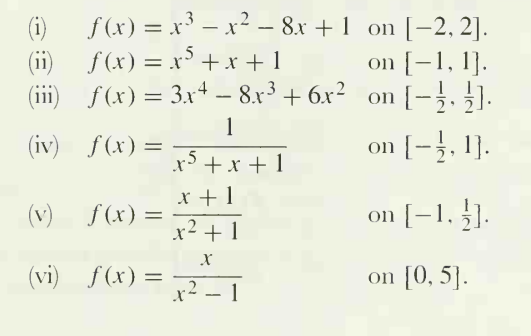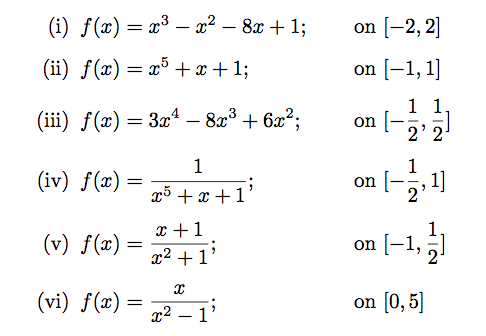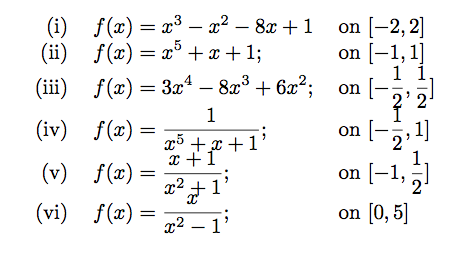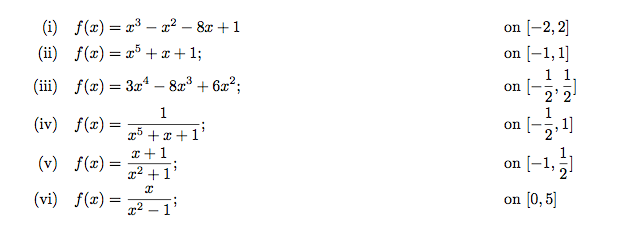lucas

Hi, is there a way to use `enumerate` like `tabular` so that the intervals in the snippet below are aligned with each other, like in the image? Thanks!
```
\usepackage[shortlabels,inline]{enumitem}
(...)
\begin{enumerate}[(i),before={\everymath{\displaystyle}}]
\item \(f(x)=x^{3}-x^{2}-8x+1 \); \([-2,2]\)
\item \(f(x)=x^{5}+x+1 \); \([-1,1]\)
\item \(f(x)=3x^{4}-8x^{3}+6x^{2}\); \([-\frac12,\frac12]\)
\item \(f(x)=\frac{1}{x^{5}+x+1}\); \([-\frac12,1]\)
\item \(f(x)=\frac{x+1}{x^{2}+1}\); \([-1,\frac12]\)
\item \(f(x)=\frac{x}{x^{2}-1}\); \([0,5]\)
\end{enumerate}
```
What I want:

Top Answer
samcarter

There are probably many possible approaches, here just a couple of them:
### Approach 1
one could make sure that the first terms in your enumerate all have the same width:
```
\usepackage[shortlabels,inline]{enumitem}
\begin{enumerate}[(i),before={\everymath{\displaystyle}}]
\item \makebox[4.5cm][l]{\(f(x)=x^{3}-x^{2}-8x+1 \);} on \([-2,2]\)
\item \makebox[4.5cm][l]{\(f(x)=x^{5}+x+1 \);} on \([-1,1]\)
\item \makebox[4.5cm][l]{\(f(x)=3x^{4}-8x^{3}+6x^{2}\);} on \([-\frac12,\frac12]\)
\item \makebox[4.5cm][l]{\(f(x)=\frac{1}{x^{5}+x+1}\);} on \([-\frac12,1]\)
\item \makebox[4.5cm][l]{\(f(x)=\frac{x+1}{x^{2}+1}\);} on \([-1,\frac12]\)
\item \makebox[4.5cm][l]{\(f(x)=\frac{x}{x^{2}-1}\);} on \([0,5]\)
\end{enumerate}
```

### Approach 2
Use a table and emulate the enumerate label in the first column:
```
\newcounter{foo}
\newcommand{\myitem}{\stepcounter{foo}(\roman{foo})}
{
\everymath{\displaystyle}
\noindent\begin{tabular}{rll}
\setcounter{foo}{0}
\myitem & \(f(x)=x^{3}-x^{2}-8x+1 \) & on \([-2,2]\)\\
\myitem & \(f(x)=x^{5}+x+1 \); & on \([-1,1]\)\\
\myitem & \(f(x)=3x^{4}-8x^{3}+6x^{2}\); & on \([-\frac12,\frac12]\)\\
\myitem & \(f(x)=\frac{1}{x^{5}+x+1}\); & on \([-\frac12,1]\)\\
\myitem & \(f(x)=\frac{x+1}{x^{2}+1}\); & on \([-1,\frac12]\)\\
\myitem & \(f(x)=\frac{x}{x^{2}-1}\); & on \([0,5]\)\\
\end{tabular}
}
```

### Approach 3
Or you could use an align environment from the `amsmath` package:
```
\newcounter{foo}
\newcommand{\myitem}{\stepcounter{foo}(\text{\roman{foo})}\quad}
\begin{flalign*}
\setcounter{foo}{0}
\myitem & f(x)=x^{3}-x^{2}-8x+1 && \text{on } [-2,2]\\
\myitem & f(x)=x^{5}+x+1; && \text{on }[-1,1]\\
\myitem & f(x)=3x^{4}-8x^{3}+6x^{2}; && \text{on } [-\frac12,\frac12]\\
\myitem & f(x)=\frac{1}{x^{5}+x+1}; && \text{on } [-\frac12,1]\\
\myitem & f(x)=\frac{x+1}{x^{2}+1}; && \text{on } [-1,\frac12]\\
\myitem & f(x)=\frac{x}{x^{2}-1}; && \text{on } [0,5]
\end{flalign*}
```
